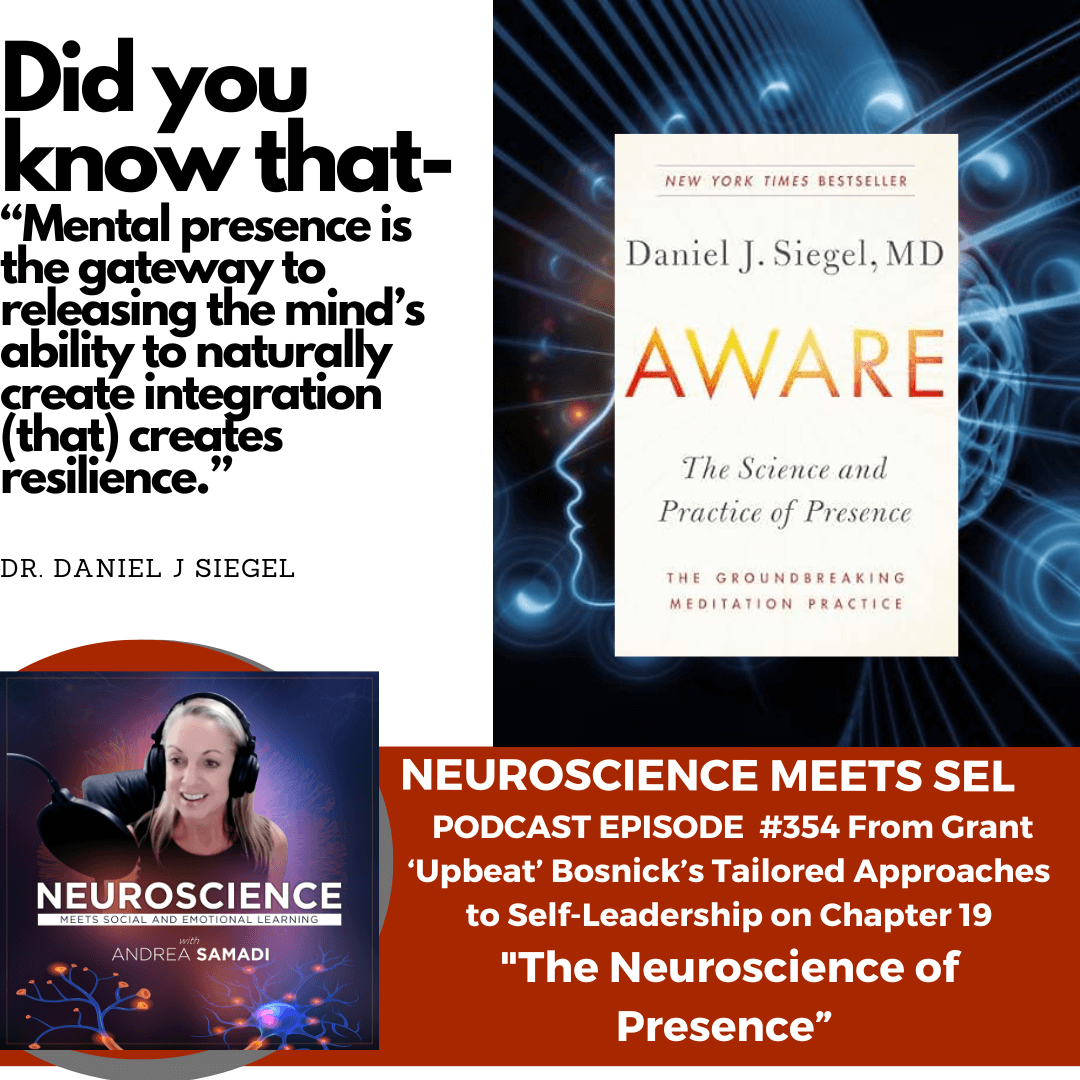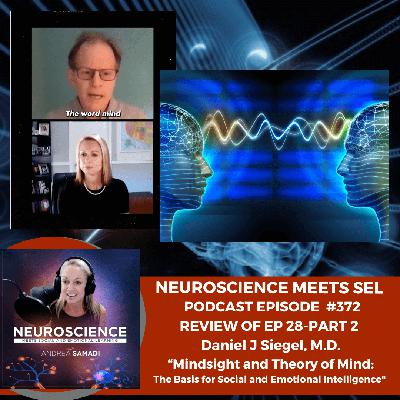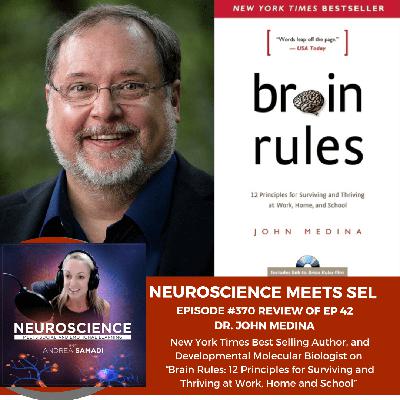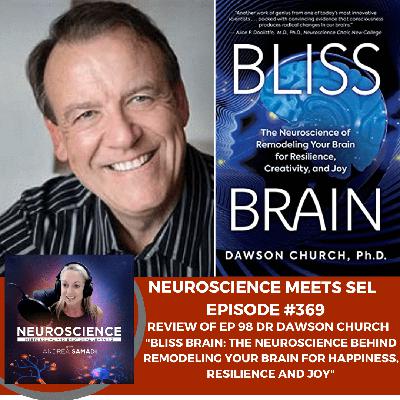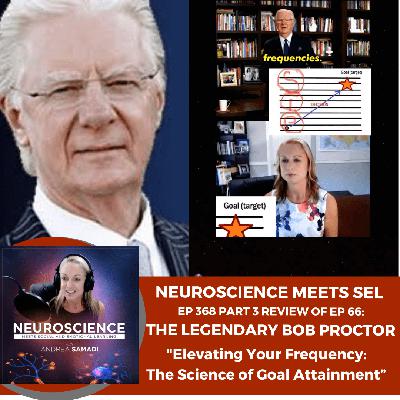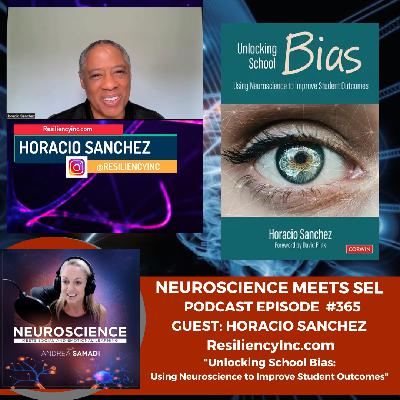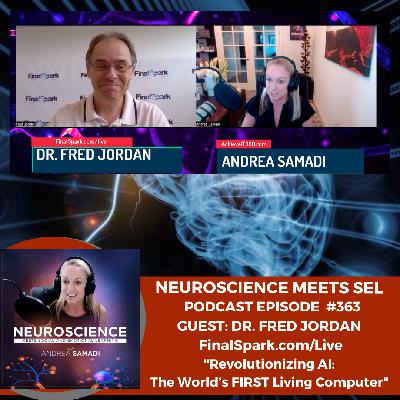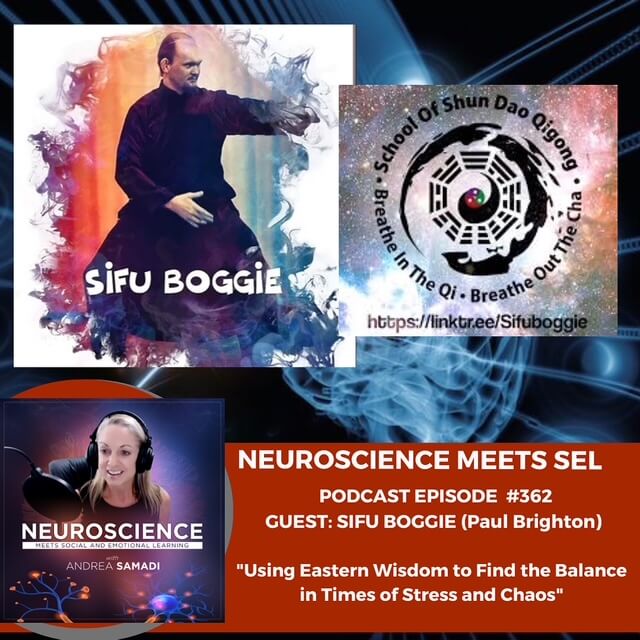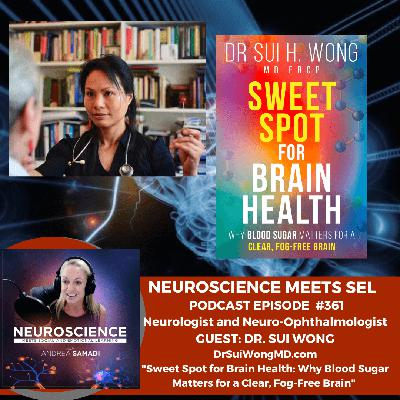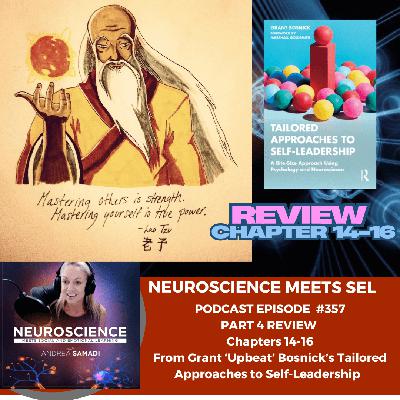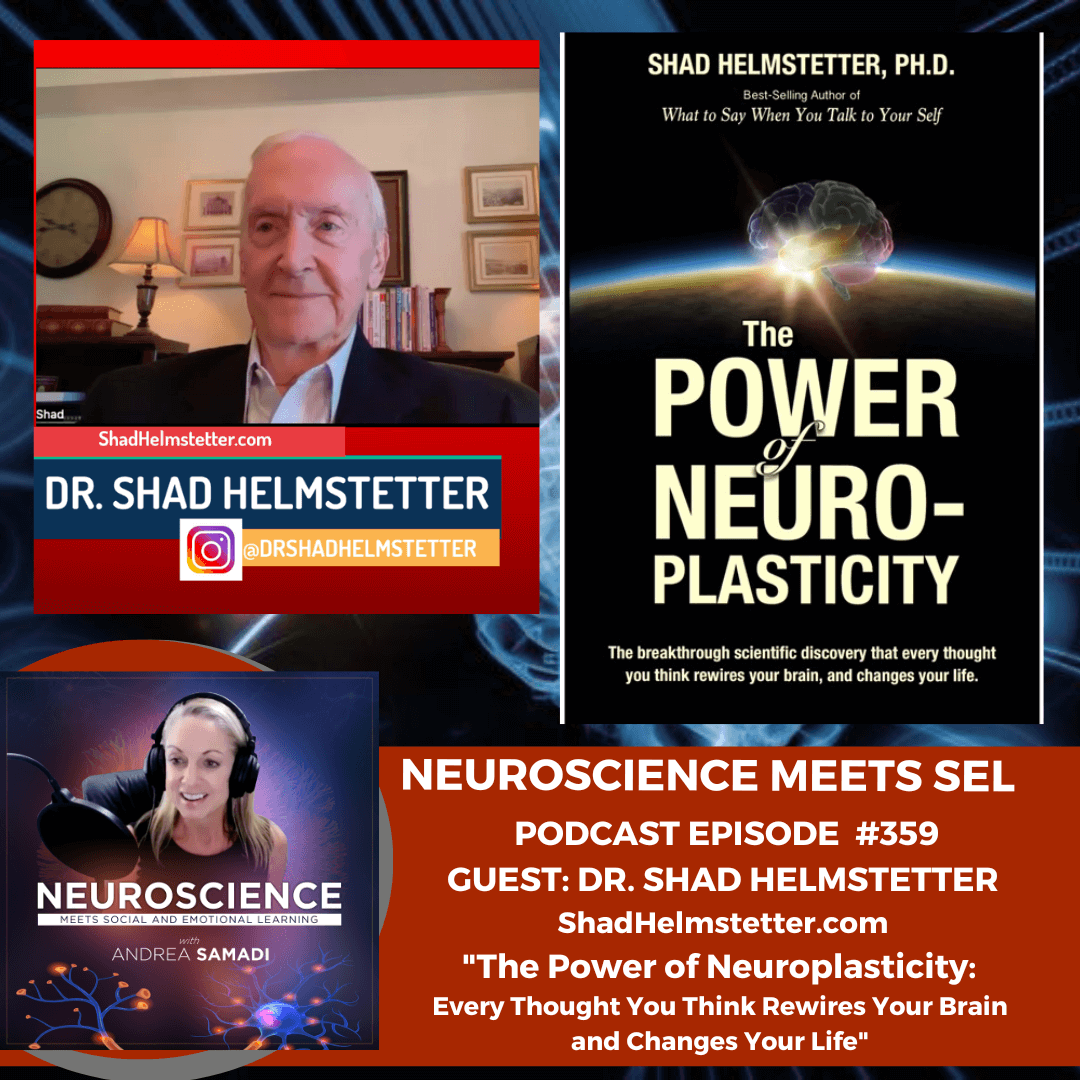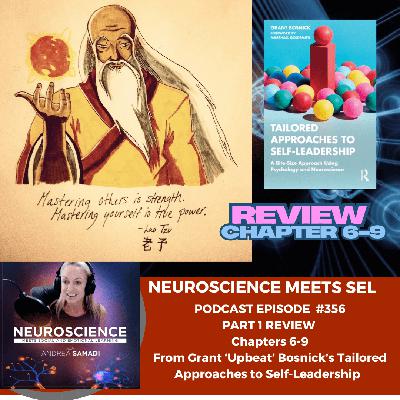Unlocking the Power of Presence: Neuroscience Meets Self-Leadership
Description
Welcome to Episode 354 of the Neuroscience Meets Social and Emotional Learning Podcast! Join host Andrea Samadi as she concludes the 18-week self-leadership series with Grant Bosnick's revolutionary insights into the neuroscience of presence. Discover how your internal thoughts, external behaviors, and interactions shape your presence, and learn practical strategies to enhance your mindfulness and connection with others.
This episode dives into Dr. Dan Siegel's 'Wheel of Awareness' meditation, offering three actionable tips to strengthen your presence in daily life. Uncover how to elevate your relationships and productivity by integrating mindfulness practices into your routine.
Whether you're striving to be the most interesting or the most interested person in the room, this episode provides valuable guidance. Prepare to close the year with heightened awareness and step into 2025 with a new perspective on leadership and personal growth.
On today's episode #354 we continue with the final topic of our 18-Week Self-Leadership Series based on Grant Bosnick’s “Tailored Approaches to Self-Leadership: A Bite Size Approach Using Psychology and Neuroscience” that we first dove into with our interview on EP #321[i] the end of January 2024. The goal was that each week, we focused on learning something new, (from Grant’s book) tied to the most current neuroscience research, that builds off the prior week, to help take us to greater heights this year. It honestly shocked me that this series took the entire year. Our final topic today, will be the neuroscience of presence, and then stay tuned for a review of the entire series to help us to move forward in 2025 with a new lens.
((On today's EPISODE #354 “The Neuroscience of Presence” we will cover)):
✔ Chapter 19 of Grant Bosnick’s Tailored Approaches to Self-Leadership with the topic of presence.
✔ Grant Bosnick’s Presence Framework with examples of subtle and direct presence.
✔ The Neuroscience of Presence using Dr. Dan Siegel’s book Aware: The Science and Practice of Presence
✔ Three Tips to Develop More Presence in our Day to Day Life.
✔ Reflections for using Mindfulness and Meditation to Improve Our Presence.
If you’ve taken the leadership self-assessment[ii], look to see if Presence (in Pathway 2), along with inspiration and motivation, persuade and influence, is of a low, medium or high priority for you to focus on this year. I was not surprised to see this pathway is a high area of focus for me as I’m always looking for new ways to motivate, inspire and influence, and presence is something I know I need to work on daily, bringing my attention back to the present moment or you might catch me daydreaming. It made me laugh when Masati Sajady mentioned he noticed this with me, back on EP 348[iii] last year. Our presence is something that can be felt, that’s for sure. Now let’s take this deeper with Grant’s book.
Grant opens up chapter 19, his final chapter, by saying that presence “is a product of our internal thoughts, external behaviors and interactions with others. It’s something (he says) that we carry with us at all times, whether we’re walking into a meeting room (or walking anywhere I might add) or sitting at a bus stop.” (Ch 19, Bosnick, Tailored Approaches to Self-Leadership, Page 252).
I can demonstrate this one easily because we have all been there. I’ll never forget Dr. Dan Siegel, who we interviewed way back in our early days of this podcast, on EP 28[iv] talking about this topic, as he watched a mother with a young child walking, and the mother was on her cell phone, not present at all. He talked about the many opportunities for connection that were lost in this instance, and I never forgot it, as I’ve been guilty of doing exactly the same thing and potentially losing out on opportunities to make meaningful connections with others.
Or think about this. In a conversation, someone is talking to you, and you notice the void. They’ve left the conversation. They are standing right in front of you, they could be looking you straight in the face, but they are no longer present mentally. You don’t need to ask them where they have gone, you can just feel it, and they eventually come back, but you know they gave you half of their attention.
Has this ever happened to you? Of course, it has.
Bosnick says that our presence “can be direct or subtle presence; and it can be controlled or uncontrolled. With direct controlled presence, we can be the most interesting person in the room—being assertive, measured and engaging (he says). With subtle controlled presence, we can be the most interested person in the room—being observant, connected and attentive.” (Ch 19, Bosnick, Tailored Approaches to Self-Leadership, Page 252) and he says “both add value in different situations.”
Whether you're striving to be the most interesting or the most interested person in the room, this episode provides valuable guidance. Prepare to close the year with heightened awareness and step into 2025 with a new perspective on leadership and personal growth.
Bosnick says that our presence “can be direct or subtle presence; and it can be controlled or uncontrolled. With direct controlled presence, we can be the most interesting person in the room—being assertive, measured and engaging (he says). With subtle controlled presence, we can be the most interested person in the room—being observant, connected and attentive.” (Ch 19, Bosnick, Tailored Approaches to Self-Leadership, Page 252) and he says “both add value in different situations.”
IMAGE CREDIT: Chapter 19 Grant Bosnick's Tailored Approaches to Self-Leadership
When I think about the most interested person in the room, my mind goes to our company Zoom meetings, where there is one person, Nikki, who always has her camera on, and she is always listening to the conversation actively, showing she is truly interested. She’s an incredible role model for the rest of us, and I find her attention to be motivating.
This past Christmas holiday, we did a Secret Santa at our work, and Nikki was one of the organizers. I thought it would be fun to participate, so I signed up for this chance to get to know some of my work colleagues in a different way. When my box arrived at my house, and we all met on a call to open our gifts together, I was blown away with the items that were bought for me. The person who was my Secret Santa knew me well!
They found out I enjoy hiking in my spare time, and bought me some items that I can really use, when I’m out on the hiking trails. This person demonstrated they were “interested” in me, with a subtle presence, by being observant, connected and attentive. Wouldn’t you know it, that my Secret Santa was Nikki! And her presence made me want to do the same thing for others.
What about the most interesting person in the room? We all know this one. With direct, controlled presence, they become “assertive, measured and engaging” and it’s hard to take your eyes off of them. They are impossible to miss. I’m sure we can all close our eyes and think of an example of someone who uses their direct, controlled presence, really well.
No one wants to be “invisible” or on the other hand “overwhelming” so this idea of presence takes practice. Bosnick says that while “some people are naturally skilled at controlling and flexing between levels of presence (like my coworker Nikki), “most of us need to consciously work at it to bring it into our control and use it to our best advantage.” (Ch 19, Bosnick, Tailored Approaches to Self-Leadership, Page 253)
So how can we improve our presence? Let’s go straight to the expert on this topic, Dr. Dan Siegel, whose book, Aware: The Science and Practice of Presence,[v] dives deep into a meditation practice, called The Wheel of Awareness, that uses science and psychology to “strengthen your capacity for presence.” (Aware, Dan Siegel).
What is the Neuroscience of Presence?
This is what Dr. Dan Siegel helps us to understand in his book, Aware that outlines why the meditation he created (The Wheel of Awareness) begins with helping us to become more mindful, but the byproduct of this mindfulness, is that “people seem interested in exploring how they might cultivate more presence in their lives so they can be healthier, happier and kinder to themselves and others.” (Dr. Siegel, Aware). Of course at the end of our interview, 6 year ago now, Dr. Siegel asked me what I was learning from doing his Wheel of Awareness Meditation every day.
I shared what I learned in an extensive review of Dr. Siegel’s Wheel of Awareness Meditation, on EP 60[vi] “The Science Behind a Meditation Practice with a Deep Dive into Dr. Dan Siegel’s Wheel of Awareness.” It took me some time to uncover what I learned, but not only does this scientifically proven meditation change the structure and function of the brain in these fascinating ways:
There’s an integration of structure and function of the brain (integration means well-being).
There’s a reduction of the stress hormone cortisol.
There’s an enhancement of immune function.
Improvement in cardiovascular risk factors.
Reduction in inflammation via epigenetic changes.
An optimization of telomerase—which is fascinating as it repairs and maintains the ends of chromosomes which slows aging.
In addition to these brain changes, I noticed an increase of ability with my 5 senses, also, with increased sensations within my body, and most importantly, what Dr. Siegel was looking to see if I noticed, was that it helped to increase my connection to people around me, expanding my “presence” far outside of myself, and into the

